Click on the exhibit button below.

If CE1 and PE1 use BGP to exchange routing information and CE2 and PE2 use static routing to forward traffic to and from the VPRN, which of the following statements is considered TRUE?
Which of the following about RSVP-TE LSP configuration in a Alcatel-Lucent 7750 SR is TRUE?
Click on the exhibit.

Which of the following is FALSE?
Click on the exhibit.
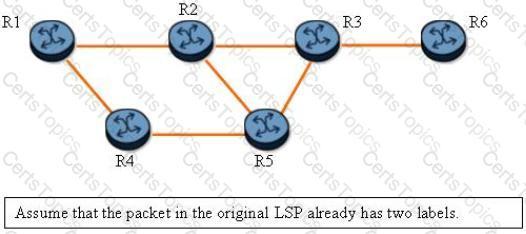
An LSP traverses the path R1-R2-R3-R6 and facility fast reroute is enabled. If the protected LSP carries one transport label and one service label, how many labels will be on the bypass tunnel if router R2 fails?
What MPLS function should be performed by a router that receives a data packet with an MPLS label value of 0?
Which of the following commands is used to create a new Epipe service?
Which of the following is NOT required to configure an Alcatel-Lucent 7750 SR as a PE router running 6PE?
Click on the exhibit.
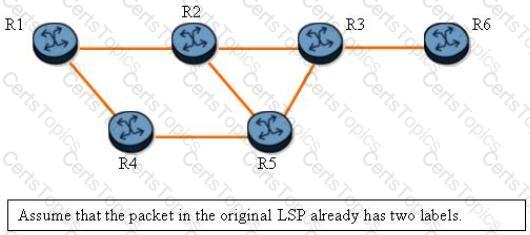
An LSP traverses R1-R2-R3-R6 and one-to-one fast reroute is enabled. If the protected LSP transports two labels, and router R2 has failed, how many labels will be on the detour path?
Click on the exhibit button below.
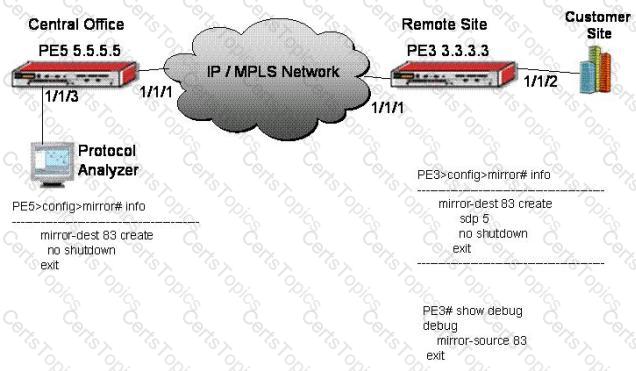
Assuming the customer only needs to monitor traffic from PE3 to the customer site, what two items are missing in the configuration of PE5, the Alcatel-Lucent 7750 Service Router in the Head Office? (Assume that the IP/MPLS network structure between the local and remote PEs is in place.)
Which of the following SAPs will forward tagged frames with an outer VLAN tag of 200? (Choose 3)
Which of the following statements best describes the flooding of traffic on a PE when traffic is received on a SAP?
Which of the following LDP message categories is UDP-based?
Which of the following about label modes on the Alcatel-Lucent 7750 SR is FALSE?
Which of the following describes how a router sets the destination IP address for an RSVP RESV message?
Click on the exhibit.
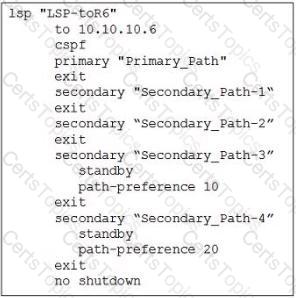
If the primary path goes down, which secondary LSP path will the head-end router select first?
Which of the following is NOT a characteristic of MPLS?
When a physical port is configured for null encapsulation, many SAPs can be configured using that port.
Fill in the blanks: A ________device has all interfaces inside the provider domain, and a _______ device has at least one interface outside the provider domain.
Click on the exhibit.
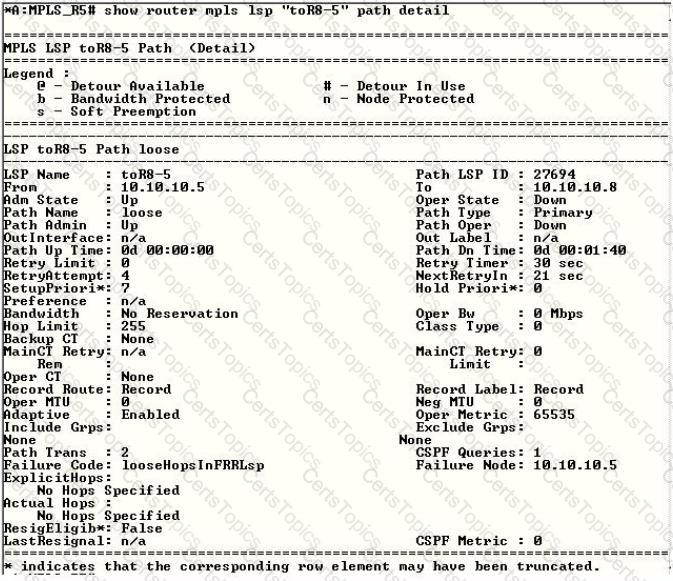
LSP " to R8-5 " requests fast reroute protection. What could be done to remove the Failure Code shown?
Which of the following about the RSVP-TE Hello protocol is FALSE?
Which of the following regarding label population is TRUE?
3 Epipe services and 2 VPLS services have been configured between two PE routers. How many service labels will be signaled in total?
Which of the following best describes a VPWS?
When provisioning a spoke-SDP on an Epipe, what MUST match on both ends of the service?
Click on the exhibit.
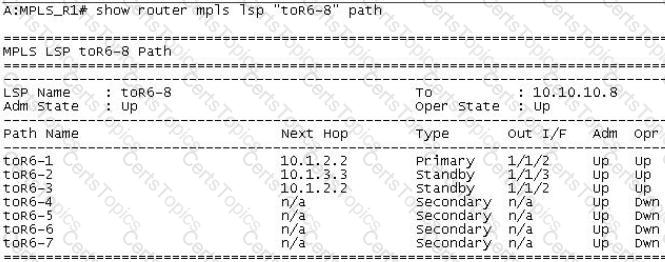
If the primary path fails, which backup LSP path will the head-end router pick first?
Click on the exhibit.
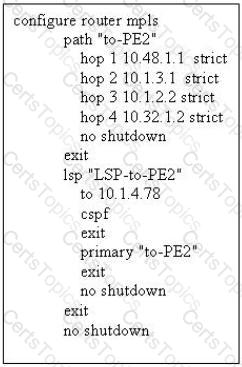
This LSP terminates on a system IP address. What is the system address of the destination node?
An LSP is configured with one-to-one FRR and node protection on a Alcatel-Lucent 7750 SR. Which of the following is FALSE?
How does a DMP inform the downstream routers that it has merged detour tunnels?
The terms "customer" and "service" are used synonymously when describing a service implementation on the Alcatel-Lucent 7750 SR.
What command syntax would be used to create a new IES service with a service id of 5 and a customer id of 1000?
Which of the following about an LSP protected with one-to-one FRR is TRUE?
What acts as the tie breaker on an Alcatel-Lucent 7750 SR if the priorities are the same when IS-IS is electing a DIS?
Which of the following is NOT a characteristic of RIPv1?:
What is the protocol number for OSPF in the IP header?
How many databases does a Link State routing protocol use?
An OSPF ASBR must have at least one interface in the backbone area (area 0)
From the list below select the statements that describe the behavior of link state information aging. (Choose 2)
What is the source IP address in an OSPF update?
Click the exhibit button.
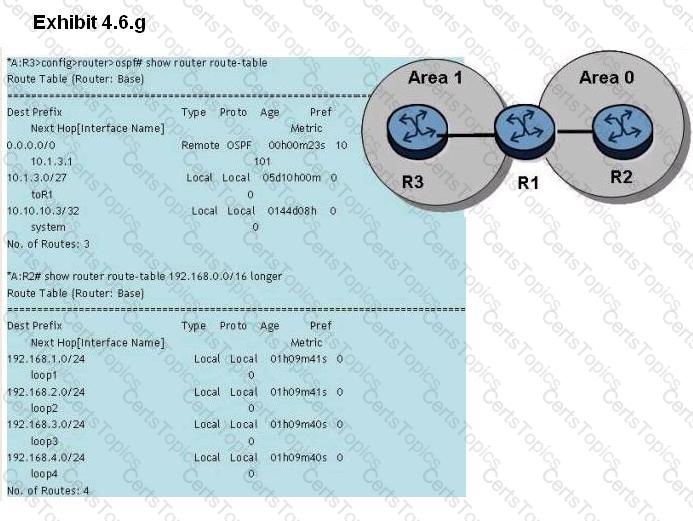
Given the topology and the show commands, and assuming that router R2 advertises all of its loopbacks into OSPF, what is the correct router R1 configuration?
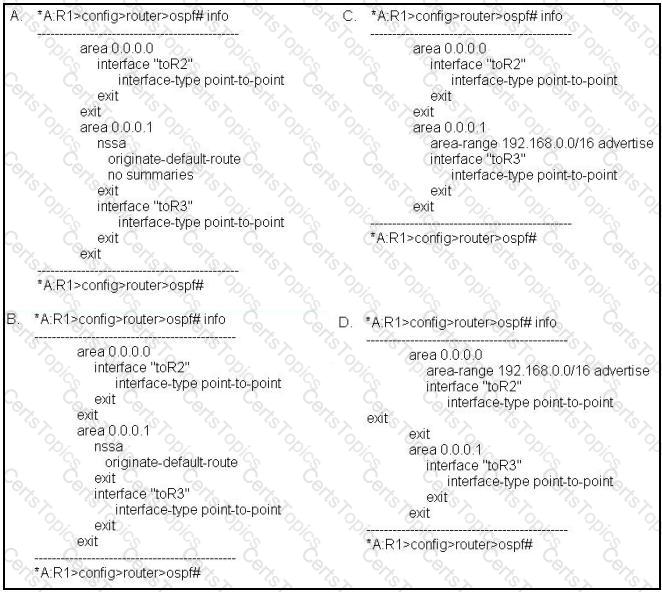
What is the default priority value used for electing the DR on an Alcatel-Lucent 7750 SR running OSPF on an Ethernet?
What are the three databases maintained by a Link State Protocol?
If routers R1 and R2 have a Level 1 and Level 2 IS-IS adjacency, which of the following statements is true? Choose two answers.
The Alcatel-Lucent 7750 SR supports which two of the OSPF area types below?
Which of the following statements apply to link state protocol behavior? Choose three answers.
Which of the following statements regarding the IS-IS CSNP is false?
Click the exhibit button.
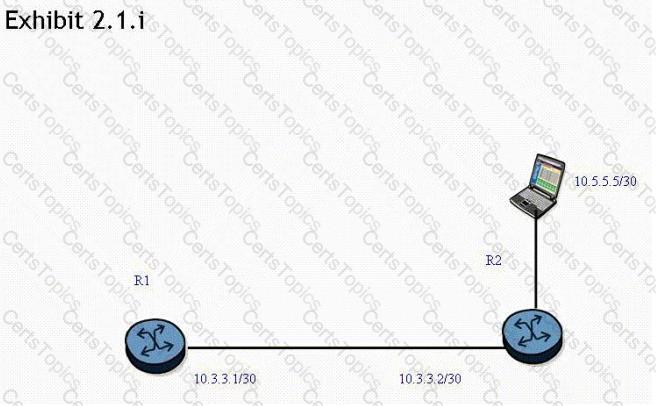
A static route is created on router R1 "using the "static-route 0.0.0.0/0 next-hop 10.3.3.2" command. What command can be used to test the static route on an Alcatel-Lucent 7750 SR?
In an OSPF Hello packet what fields must match all neighbor routers on the segment? (Choose 3)
An Alcatel-Lucent 7750 SR receives a route via an IS-IS LSP with internal reach ability, and receives the same route via an OSPF type 5 LSA. If al protocol preferences are default, which route will be installed in the route table?
Which of the following correctly lists the 5 OSPF packet types?
Which of the following statements best describes an OSPF type 3 LSA?
In an IP datagram, which of the following fields identifies the receiving application?
Which of the following conditions will prevent an OSPF adjacency from reaching the full state? Choose three answers.
In an OSPF environment, what must a router receive after it sends out an update?
What is wrong with the following filter configuration from an Alcatel-Lucent 7750 SR?
RTR-B# configure filter
RTR-B>config>filter# ip-filter 1 create
RTR-B>config>filter>ip-filter$ entry 1 create
RTR-B>config>filter>ip-filter>entry$ match src-ip 172.2.0.0/16
RTR-B>config>filter>ip-filter>entry# action drop
RTR-B# configure router interface toRTR-A
RTR-B>config>router>if# egress
RTR-B>config>router>if>egress# filter ip 1
Click the exhibit button.
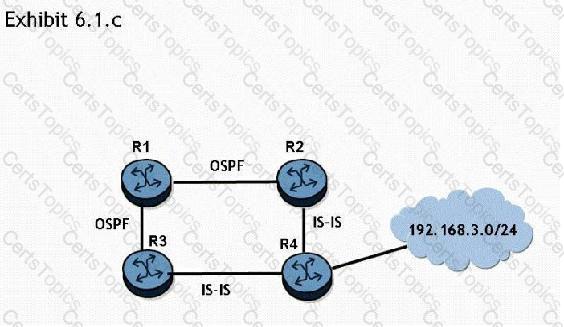
If router R2 redistributes the IS-IS route to 192.168.3.0/24 into OSPF, router R3 preference of these two routes? Choose two answers.
Click the exhibit button.
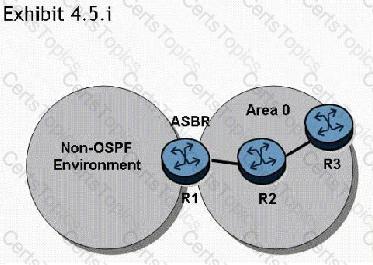
In the topology shown, router R1 is an ASBR configured to export external routes to OSPF. How many type 4 LSAs will be present in the network?
Graceful Restart is supported by what IGPs?
Click the exhibit button.

Router 2 advertises the network 192.168.3.0/24 to router R1 via IS-IS.
How can router R1 ensure that it discards the route?
Which of the following TLV fields is included in an IS-IS Hello packet?
When redistributing OSPF into RIP V2 what must be taken into consideration for the redistribution to take place?
There is an IP host with IP address 10.2.3.1. A static route is created, using the "configure router static-route 10.2.3.0/24 next-hop 10.1.2.1" command. What is the correct traceroute command to test this static route on an Alcatel-Lucent 7750 SR?
Which of the following statements regarding the election of the designated router (DR) by OSPF routers are true? (Choose two)
Which of the LSA types stay within an OSPF area and are not exported outside of the area? (Choose all that apply)
What Alcatel-Lucent 7750 SR OAM tool can be used to verify the end-to-end connectivity of a service?
Which of the following about ADSPEC is FALSE?
Click the exhibit.
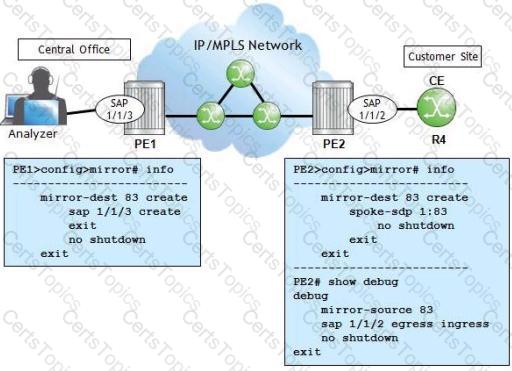
PE1 and PE2 are Alcatel-Lucent 7750 SRs. What needs to be added to PE1's configuration to mirror traffic between PE2 and the customer site?
What happens by default on an Alcatel-Lucent 7750 SR when a VPLS accepts a tagged frame at the ingress SAP 1/1/1:100?
Which utility on the Alcatel-Lucent 7750 SR can be used to investigate an MPLS path?
Click the exhibit.
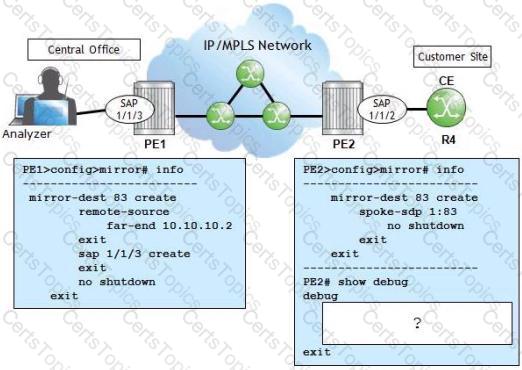
PE1 and PE2 are Alcatel-Lucent 7750 SRs. Which of the following is the missing configuration required on PE2 to complete the mirror?
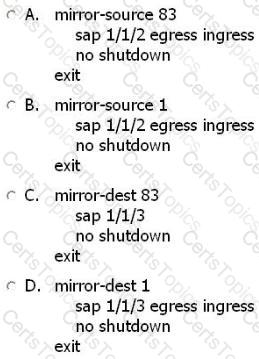
How many service labels must be signaled to bring up a fully-meshed VPLS among five PE routers?
By default, what does an Alcatel-Lucent 7750 SR do to support VPLS services for different customers?
Click the exhibit. This output is from router R4. Service 333 is a VPLS. Why might the peer 10.10.10.1 have the same value for IngLbl and EgrLbl?
A customer requests that their Layer 2 Ethernet service be configured to forward frames up to 1500 bytes. The service provider is using MPLS encapsulation (without RSVP-TE fast-reroute) on their IP/MPLS network. What is the minimum MTU setting for the network ports?
Which of the following about the Alcatel-Lucent 7750 SR's sdp-ping utility is FALSE?
A SAP configured in the form of 1/1/1:0/32 would be used for which type of VPWS?
Which of the following commands is used to enable an E-pipe service?
Click the exhibit.
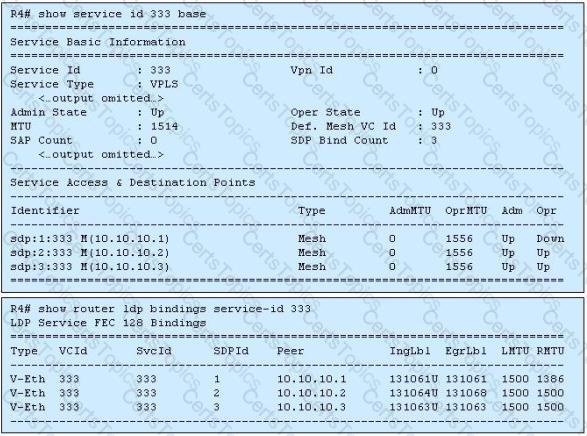
Both clips of output are from router R4. The show service command indicates that an SDP is down. What might be the cause?
Click the exhibit.
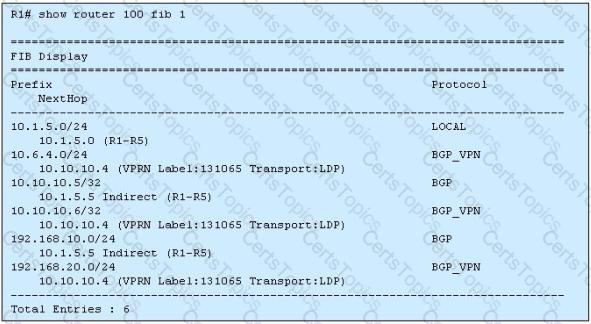
The output is from PE router R1 about VPRN service 100. From which protocol did router R1 learn the prefix 192.168.20.0/24?
Which of the following about VPRN labels is FALSE?
On an Alcatel-Lucent 7750 SR, which of the following about a VPLS is FALSE?
On an Alcatel-Lucent 7750 SR, the OAM command 'svc-ping' can be used with options bcal-sdp' and 'remote-sdp'. Which of the following is TRUE?
Which of the following statements best describes how an FDB is populated with MAC addresses in a VPLS service?
Which of the following about 6VPE is FALSE?
On an Alcatel-Lucent 7750 SR, which vc-type will strip service delimiting tags at the ingress PE?
Click the exhibit.
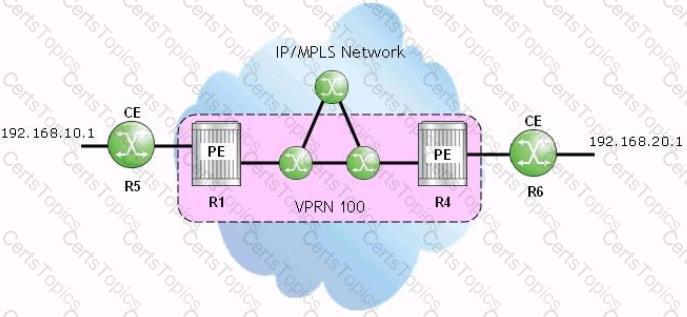
The CEs use BGP and export policies to advertise their local prefixes with the VPRN on their PEs. If the VPRN is functioning properly, which of the following commands will succeed when performed on router R1?
Click the exhibit.
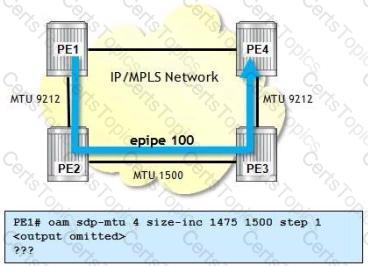
E-pipe 100 is using an SDP (4) with an LSP that uses the path shown (PE1-PE2-PE3-PE4). Which of the following is the expected output from the OAM command?
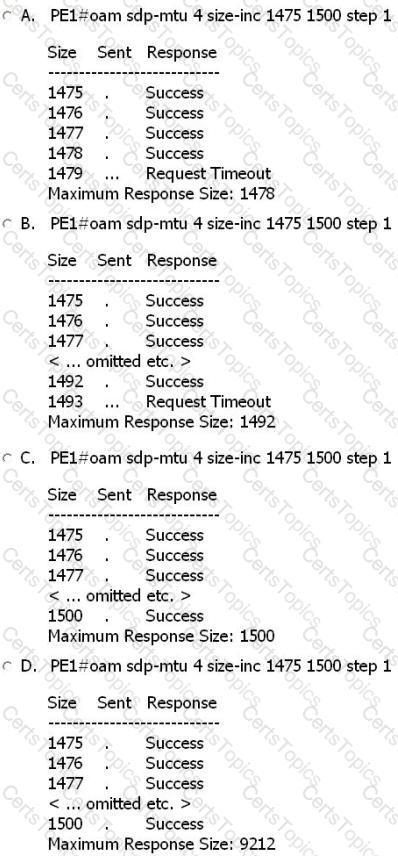
Which of the following about VPLS MAC learning is TRUE?
An IPv4 MPLS provider network is being configured for 6VPE. BGP is being used for the PE-CE protocol to exchange IPv6 routes. Which of the following is FALSE?
On the Alcatel-Lucent 7750 SR, which of the following statements about MP-BGP used for a VPRN is TRUE?
What is the best approach of making MTUs match between a VPLS and a spoke IES in order to bring up the service?
Click the exhibit.
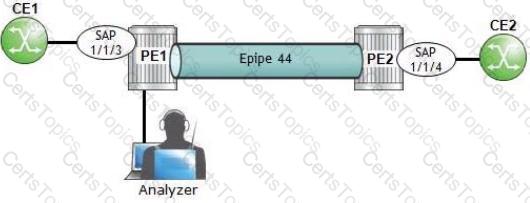
An operator at PE1 wants to analyze the traffic between CE1 and PE1 on SAP 1/1/3, On an Alcatel-Lucent 7750 SR, which of the following is NOT required as part of the configuration?
How many service labels must be signaled to bring up a fully-meshed VPLS among three PE routers?
Which of the following is TRUE when a service uses a GRE transport tunnel?
Which protocol is used to signal the inner label for a L2-VPN service?
Which of the following MUST be identical for a service between two PEs?
Click on the exhibit.
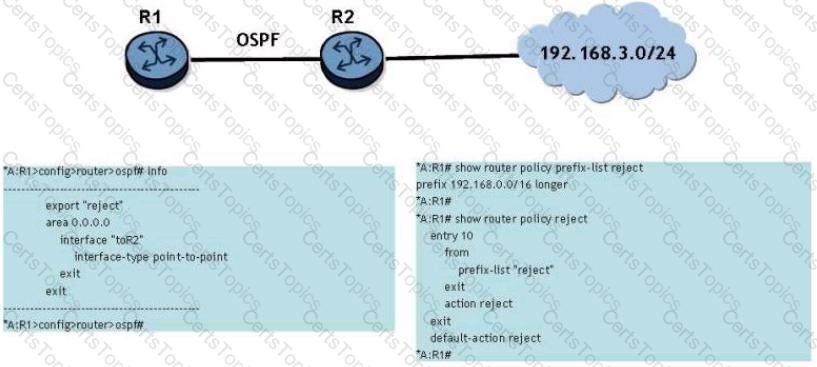
Router R2 uses OSPF to advertise the network 192.168.3.0/24 to router R1. A route policy has been configured to reject the route on router R1.
Why doesn't the route policy work?
Which of the following about IS-IS level hierarchies is FALSE?
You wish to advertise LDP labels for all local networks; which is the most effective policy statement to use?
Click on the exhibit.
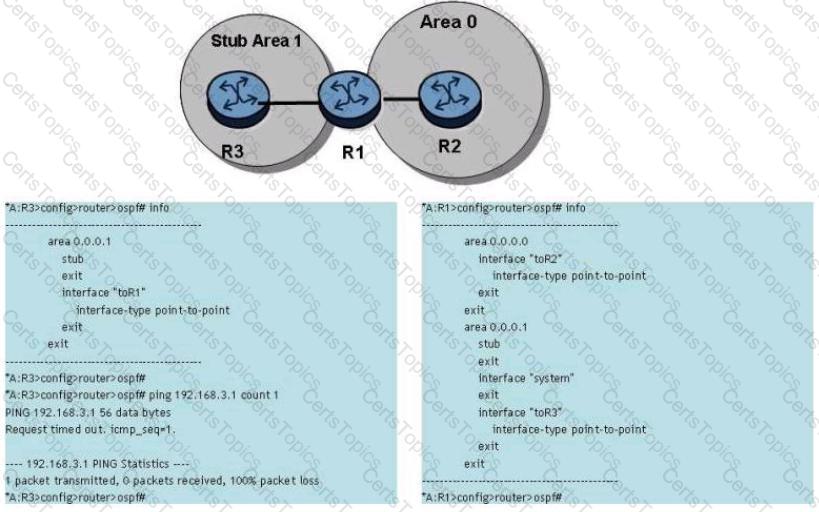
192.168.3.1 is a loopback interface on router R2 and is distributed to OSPF area 0, but the ping fails from router R3. Which of the following is a possible solution to the problem?
Click on the exhibit.

What triggers convergence of the routing protocol when the link between switch 1 and switch 2 goes down?
Router R4 originates 500 RSVP signaled LSPs with default hello and refresh timer settings If the only downstream communication fails (link is operationally UP), how long will RSVP wait before it declares the RSVP sessions down?
Click the exhibit button.
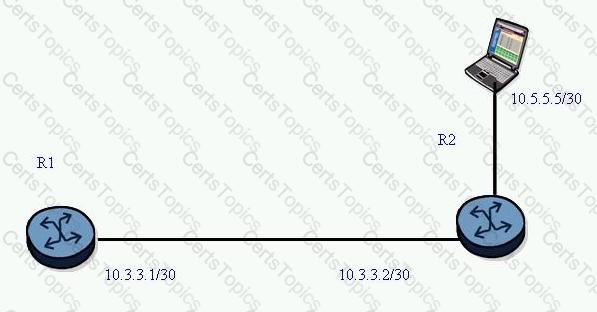
A static route is created on router R1 using the command "static-route 0.0.0.0/0 next-hop 10.3.3.2". What command can be used to test the static route on an Alcatel-Lucent 7750 SR?
Which part of the NSAP address is used to indicate to the end system that a packet is to be processed by the router itself?
An Alcatel - Lucent 7750 SR receives a route from an IS-IS LSP with internal reachability, and receives the same route from an OSPF Type 5 LSA. If all protocol preferences are default, which route will be installed in the route table?
Click on the exhibit.
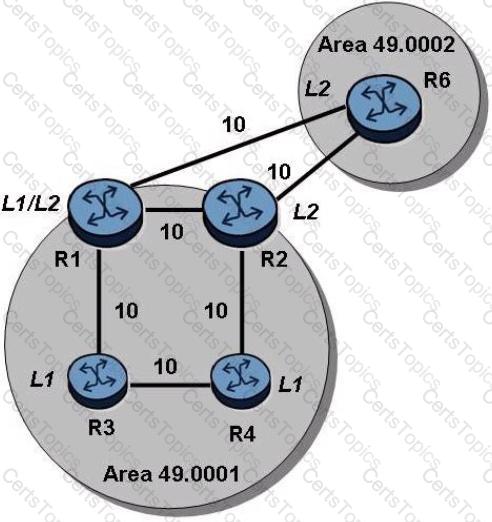
Examine the physical topology of the IS-IS network, the metrics of the links and the levels of the routers. All routers have a system address included in IS-IS.
Which of the following describes the route that router R4 will use to reach the system address of router R6?
Two IS-IS L1/L2 routers are in the same area on the same Ethernet segment. One of the routers is the DIS. How many adjacencies will be formed between them?
Which of the following regarding the IS-IS PSNP is FALSE?
Which of the following best describes the forwarding of a IPv6 packet that has a destination anycast address?
Click on the exhibit button below.
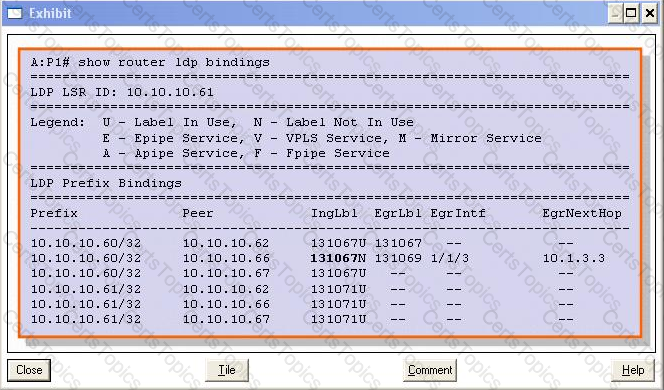
Consider the output shown; why is the label in bold font not in use?
Click on the exhibit button below. Assume the following:
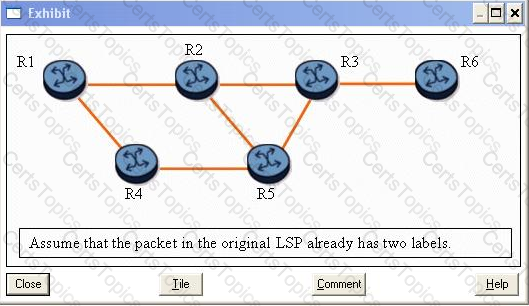
- The protected path is R1-R2-R3-R6.
- Fast reroute one-to-one protection is enabled.
If the original LSP already has two labels, and router R2 has failed, how many labels will there be in packets on the detour path?
Which of the following is a difference between IS-IS and OSPF?
In MPLS, how is the label range 0 ?15 used?
Which of the following statements regarding RSVP refresh reduction are true1? (Choose two)
Which of the following statements regarding DiffServ-TE LSPs is true?
Which of the following statements best describe MPLS fast reroute characteristics? (Choose two)
Which of the following are features of RSVP-TE? Choose three answers.
Click on the exhibit.
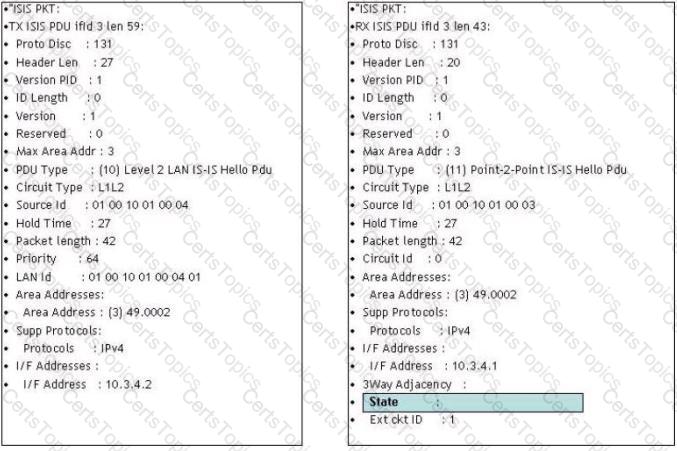
What value would be expected in the state field?
Which of the following best describes the function of an OSPF Type 4 LSA?
Click on the exhibit button below.
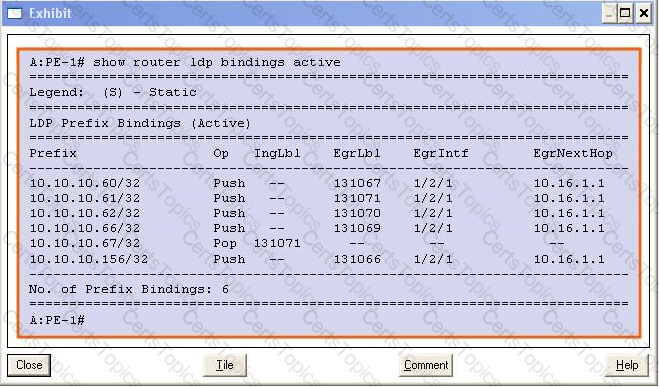
Consider the output shown; what table is displayed?
Click on the exhibit.
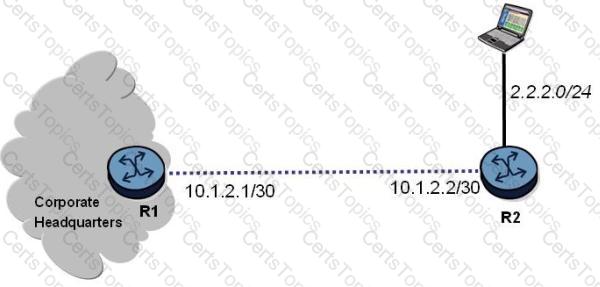
What is the correct command to configure a default route on the Alcatel-Lucent 7750SR R2?
Which of the following concerning OSPFv3 is TRUE?
An OSPF adjacency is stuck in the exstart state. What is the most likely cause?
Click on the exhibit.
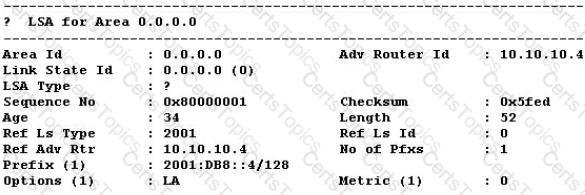
What type of OSPFv3 LSA is shown?
Click on the exhibit.
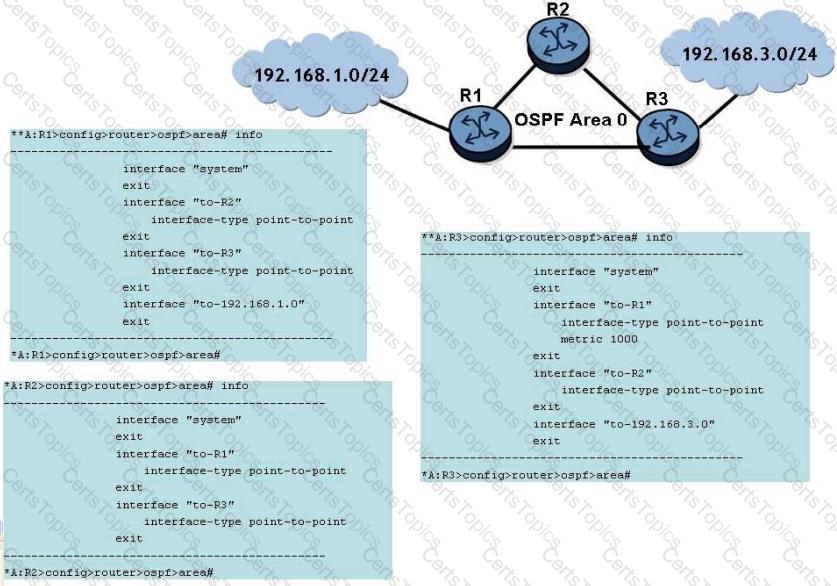
All ports in the network are operationally up and have a speed of 1Gbps. Which of the following is TRUE?
Click on the exhibit.
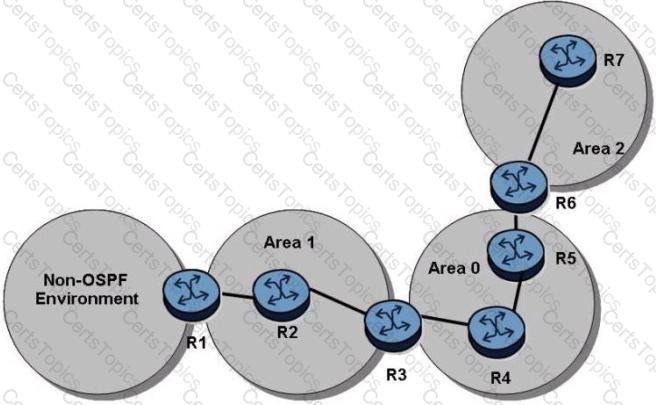
In the topology shown, router R1 is an ASBR configured to export external routes to OSPF. There are no stub or NSSA areas. Which of the following regarding LSAs is TRUE?
Which of the following best describes the actions taken by an IS-IS router after it receives an LSP on a broadcast interface that is newer than the one in its database?